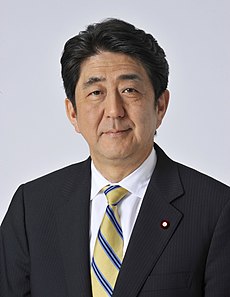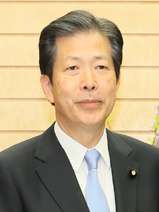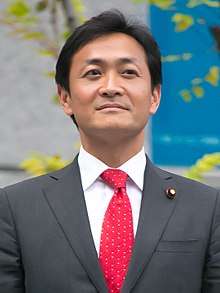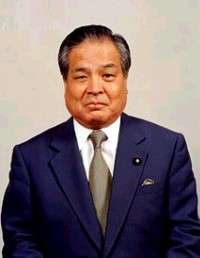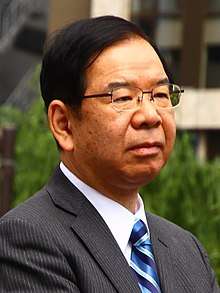2019 Japanese House of Councillors election
The 25th regular election of members of the House of Councillors (dai-nijūgo-kai Sangiin giin tsūjō senkyo, 第25回参議院議員通常選挙) was held on 21 July 2019 to elect 124 of the 245 members of the House of Councillors, the upper house of the then 710-member bicameral National Diet of Japan, for a term of six years.
| |||||||||||||||||||||||||||||||||||||||||||||||||||||||||||||||||||||||||||||||||||||||||||||||||||||||||||||||||||||||||||||||||||||||||||||||||||||||||
124 (of the 245) seats in the House of Councillors 123 seats needed for a majority | |||||||||||||||||||||||||||||||||||||||||||||||||||||||||||||||||||||||||||||||||||||||||||||||||||||||||||||||||||||||||||||||||||||||||||||||||||||||||
|---|---|---|---|---|---|---|---|---|---|---|---|---|---|---|---|---|---|---|---|---|---|---|---|---|---|---|---|---|---|---|---|---|---|---|---|---|---|---|---|---|---|---|---|---|---|---|---|---|---|---|---|---|---|---|---|---|---|---|---|---|---|---|---|---|---|---|---|---|---|---|---|---|---|---|---|---|---|---|---|---|---|---|---|---|---|---|---|---|---|---|---|---|---|---|---|---|---|---|---|---|---|---|---|---|---|---|---|---|---|---|---|---|---|---|---|---|---|---|---|---|---|---|---|---|---|---|---|---|---|---|---|---|---|---|---|---|---|---|---|---|---|---|---|---|---|---|---|---|---|---|---|---|---|
| |||||||||||||||||||||||||||||||||||||||||||||||||||||||||||||||||||||||||||||||||||||||||||||||||||||||||||||||||||||||||||||||||||||||||||||||||||||||||
| |||||||||||||||||||||||||||||||||||||||||||||||||||||||||||||||||||||||||||||||||||||||||||||||||||||||||||||||||||||||||||||||||||||||||||||||||||||||||
74 members were elected by single non-transferable vote (SNTV)/First-past-the-post (FPTP) voting in 45 multi- and single-member prefectural electoral districts. The nationwide district elected 50 members by D'Hondt proportional representation with optionally open lists, the previous most open list system was modified in 2018 to give parties the option to prioritize certain candidates over the voters' preferences in the proportional election.[2][3]
The election saw Prime Minister Shinzo Abe's ruling coalition lose the two-thirds majority needed to enact constitutional reform.[4][5] The Liberal Democratic Party also lost its majority in the House of Councillors, but the LDP maintained control of the House of Councillors with its junior coalition partner Komeito.
Background
The term of members elected in the 2013 regular election (including those elected in subsequent by-elections or as runners-up) was to end on 28 July 2019. Under the "Public Offices Election Act" (kōshoku-senkyo-hō), the regular election must be held within 30 days before that date, or under certain conditions if the Diet is in session or scheduled to open at that time, between 24 and 30 days after the closure of the session and thus potentially somewhat after the actual end of term.[6]
Going into the election, the Liberal Democratic Party and its coalition partner Komeito controlled a two-thirds super-majority of seats in the House of Representatives but did not control a similar super-majority of seats in the House of Councillors, necessary to initiate amendments of the Constitution of Japan.
Pre-election composition
(as of 15 March 2018)[7]
| ↓ | |||||||
| 44 | 32 | 6 | 8 | 11 | 70 | 14 | 57 |
| Opposition seats not up | O seats up | RO | RO up | K up | LDP-PJK seats up | K | LDP-PJK seats not up |
In the class of members facing re-election, the ruling coalition of the Liberal Democratic Party (LDP), Kōmeitō and Party for Japanese Kokoro (PJK) had a combined 81 of 121 seats (as of March 2018).[7] The governing coalition would have to lose 30 seats or more to forfeit its overall majority in the House of Councillors and face a technically divided Diet. However, as independents and minor opposition groups might be willing to support the government on a regular basis without inclusion in the cabinet, the losses required to face an actual divided Diet may have been much higher. If the Diet is divided after the election, the coalition's two-thirds majority in the House of Representatives can still override the House of Councillors and pass legislation, but certain Diet decisions, notably the approval of certain nominations by the cabinet such as public safety commission members or Bank of Japan governor, would require the cooperation of at least part of the opposition or an expansion of the ruling coalition.
Among the members facing re-election were House of Councillors President Chuichi Date (LDP, Hokkaido), Kōmeitō leader Natsuo Yamaguchi (K, Tokyo) and Minister of Economy, Trade and Industry Hiroshige Seko (LDP, Wakayama at-large district).
District reapportionment
The following districts saw a change in their representation within the House at this election. One set of reforms were introduced in 2012 and first took effect at the 2013 election. The districts below are affected by the 2015 reforms, which started to take effect in the 2016 election.
In May 2018, the government announced that they are planning to introduce a revision into the Public Offices Election Law before the 2019 election. The proposed changes increased the number seats in the House by 6, 2 seats in the Saitama at-large district and 4 in the national PR block. As Saitama currently has the highest voters-to-councillor ratio, the increase would reduce its ratio gap with the least populous district (below the constitutional 3 to 1 limit). Meanwhile the seat increase in the PR block is aimed to address the absence of representation of prefectures in the merged-prefecture districts (namely Tottori-Shimane and Tokushima-Kōchi) and popular discontent in those prefectures. The plan also introduced a ranking system for the PR lists. This essentially changed it from a most open list system into a less open list system, mirroring the one used in the House of Representatives elections. To reduce the chance of the non-representation of a prefecture, candidates from prefectures not running in the merged districts were to be prioritised on the list.[8]
Under the plan, the new Saitama seat and two new PR seats were contested in 2019, while the other three would be contested in 2022.
| District | Magnitude | Notes |
|---|---|---|
| Hokkaidō | 3 | Increased from 2 |
| Miyagi | 1 | Decreased from 2 |
| Tokyo | 6 | Increased from 5 |
| Niigata | 1 | Decreased from 2 |
| Nagano | 1 | Decreased from 2 |
| Aichi | 4 | Increased from 3 |
| Hyogo | 3 | Increased from 2 |
| Tottori-Shimane | 1 | Created from the merger of the single-member Tottori and Shimane districts |
| Tokushima-Kōchi | 1 | Created from the merger of the single-member Tokushima and Kochi districts |
| Fukuoka | 3 | Increased from 2 |
Polls
Proportional vote intention
| Date | Polling firm/source | LDP | CDP | DPP | Kibō | Komei | JCP | Ishin | SDP | LP | Reiwa | Other | Und. | DK/ no ans. |
Lead | |
|---|---|---|---|---|---|---|---|---|---|---|---|---|---|---|---|---|
| 13–14 Jul | Asahi Shimbun | 35 | 12 | 2 | N/A | 6 | 6 | 6 | 2 | N/A | 1 | 1 | 29 | 6 | ||
| 6–7 Jul | JNN | 33.7 | 8.6 | 0.9 | 4.7 | 2.8 | 3.9 | 0.6 | 0.7 | 28.4 | 0.9 | 5.3 | ||||
| 4–5 Jul | Yomiuri Shimbun | 36 | 10 | 3 | 6 | 4 | 7 | 1 | 0 | 25 | 9 | 11 | ||||
| 28–30 Jun | Nikkei | 44 | 14 | 1 | 6 | 4 | 6 | 2 | N/A | N/A | 18 | 5 | 26 | |||
| 28–30 Jun | Yomiuri Shimbun | 40 | 10 | 2 | 5 | 4 | 6 | 2 | 0 | 23 | 7 | 17 | ||||
| 26–27 Jun | Kyodo News | 28.8 | 9.0 | 1.6 | 5.6 | 3.4 | 3.2 | 1.2 | 0.2 | 39.2 | 0.9 | 10.4 | ||||
| 22–23 Jun | Asahi Shimbun | 40 | 13 | 2 | 6 | 5 | 6 | 1 | 1 | 2 | 23 | 17 | ||||
| 5 Jun | Kibō no Tō loses its legal status as a political party and becomes a political organization. | |||||||||||||||
| 1–2 Jun | JNN | 41.0 | 7.0 | 1.1 | 0.2 | 3.2 | 3.6 | 2.2 | 0.3 | N/A | 0.6 | 26.3 | 14.5 | 14.7 | ||
| 18–19 May | ANN | 35.9 | 9.9 | 1.3 | 0.0 | 5.5 | 3.2 | 3.3 | 0.9 | 1.3 | N/A | 34.6 | 26 | |||
| 18–19 May | Asahi Shimbun | 37 | 12 | 3 | 1 | 6 | 5 | 7 | 1 | 2 | N/A | 26 | 25 | |||
| 18–19 May | Kyodo News | 38.2 | 11.2 | 1.1 | 0.4 | 4.1 | 3.8 | 4.6 | 0.7 | 0.1 | N/A | 35.8 | 27 | |||
| 11–12 May | JNN | 38.4 | 7.3 | 0.8 | 0.3 | 3.9 | 3.3 | 3.2 | 0.6 | 0.6 | 29.2 | 12.5 | 31.1 | |||
| 10–12 May | Nikkei & TV Tokyo | 43 | 11 | 2 | 0 | 5 | 4 | 7 | 1 | 0 | 19 | 7 | 32 | |||
| 26 Apr | The Liberal Party is merged into the Democratic Party for the People. | |||||||||||||||
| 20–21 Apr | ANN | 35.4 | 9.1 | 1.1 | 0.1 | 4.3 | 4.9 | 4.5 | 0.6 | 0.1 | 0.5 | N/A | 34.3 | 26.3 | ||
| 6 Mar – 15 Apr | Asahi Shimbun | 43 | 17 | 3 | 1 | 5 | 5 | 6 | 2 | 1 | 2 | N/A | 15 | 26 | ||
| 13–14 Apr | Asahi Shimbun | 39 | 13 | 2 | 0 | 5 | 6 | 7 | 1 | 1 | 2 | N/A | 24 | 26 | ||
| 6–7 Apr | JNN | 38.5 | 6.5 | 0.9 | 0.1 | 3.8 | 3.4 | 2.5 | 0.7 | 0.3 | 0.2 | 28.7 | 14.3 | 32 | ||
Results
| ↓ | |||||||
| 88 | 16 | 28 | 113 | ||||
| Opposition and independents | Ishin | Kōmeitō | Liberal Democratic | ||||

 | |||||||||||||||||||
| Parties | Constituencies | Proportional | Seats | ||||||||||||||||
|---|---|---|---|---|---|---|---|---|---|---|---|---|---|---|---|---|---|---|---|
| Votes | % | Seats | Votes | % | Seats | Total before |
Not up | Won | Total after |
+/- | |||||||||
| Liberal Democratic Party | 20,330,963 | 39.77 | 38 | 17,711,862 | 35.37 | 19 | 125 | 56 | 57 | 113 | |||||||||
| Constitutional Democratic Party | 7,951,430 | 15.79 | 9 | 7,917,719 | 15.81 | 8 | 28 | 15 | 17 | 32 | |||||||||
| Komeito | 3,913,359 | 7.77 | 7 | 6,536,336 | 13.05 | 7 | 25 | 14 | 14 | 28 | |||||||||
| Nippon Ishin no Kai | 3,664,530 | 7.28 | 5 | 4,907,844 | 9.80 | 5 | 11 | 6 | 10 | 16 | |||||||||
| Communist Party | 3,710,768 | 7.37 | 3 | 4,483,411 | 8.95 | 4 | 14 | 6 | 7 | 13 | |||||||||
| Democratic Party for the People | 3,256,859 | 6.47 | 3 | 3,481,053 | 6.95 | 3 | 27 | 15 | 6 | 21 | New | ||||||||
| Reiwa Shinsengumi | 214,438 | 0.43 | 0 | 2,280,764 | 4.55 | 2 | 0 | 0 | 2 | 2 | New | ||||||||
| Social Democratic Party | 191,820 | 0.38 | 0 | 1,046,011 | 2.09 | 1 | 2 | 1 | 1 | 2 | |||||||||
| Party to Protect the People from NHK | 1,521,344 | 3.02 | 0 | 987,885 | 1.97 | 1 | 0 | 0 | 1 | 1 | New | ||||||||
| Others (5 parties) | 79,398,217 | 1.14 | 0 | 450,501,748 | 1.44 | 0 | 0 | 0 | 0 | 0 | - | ||||||||
| Independents | 5,335,641 | 10.59 | 9 | 10 | 8 | 9 | 17 | ||||||||||||
| Valid votes | 50,363,771 | - | 50,072,199 | ||||||||||||||||
| Blank and invalid votes | 1,308,151 | - | 1,394,498 | ||||||||||||||||
| Total | 51,671,922 | 100 | 74 | 51,666,697 | 100 | 50 | 242 | 121 | 124 | 245 | +3 | ||||||||
| Registered voters / turnout | 105,886,064 | 48.80 | - | 105,886,064 | 48.79 | ||||||||||||||
| Source : Results | |||||||||||||||||||
References
- Sole leader since 4 September 2018.
- NHK kaisetsu blog archive, 19 July 2018: 「参院定数6増 比例特定枠導入~選挙制度改革行方は」(時論公論)
- MIC, electoral system news, 24 October 2018: 参議院議員選挙制度の改正について
- "Forces seeking to change Japan's Constitution to lose 2/3 majority in upper house". July 22, 2019 – via Mainichi Daily News.
- "Abe wins upper house poll but suffers constitutional reform setback". Kyodo News+.
- e-gov legal database: 公職選挙法 Archived 2016-07-29 at the Wayback Machine, chapter 5 (election dates), article 32 (regular elections)
- House of Councillors: Members Strength of the Political Groups in the House (only caucus totals and female members; full Japanese version partitioned by class/end of term and election segment 会派別所属議員数一覧)
- Hisanaga, Ryuichi (29 May 2018). "LDP compiles plan to revise Upper House election system". Asahi Shimbun. Retrieved 30 May 2018.
